Diatoms, hard-to-degrade marine microalgae, are efficient at removing atmospheric CO2
By Miguel Cabrera-Brufau and collaborators
 Marine microscopic algae, known as phytoplankton, are responsible for approximately half of the photosynthesis that occurs annually on the planet, converting large amounts of CO2 into organic matter. A fraction of the organic matter produced at the sun-lit surface ocean sinks towards the ocean floor in the form of particles, which are progressively degraded by microbes on their way down. How fast this particulate organic matter is degraded controls how much carbon will be stored away from the atmosphere and for how long, influencing the Earth climate. Extensive research has been conducted on the physiology, ecology and distribution of different phytoplankton groups, but we do not know how the presence of different phytoplankton species influences the degradability of the particulate organic matter they produce. We compared the degradation dynamics of two phytoplankton proliferations that differed in the contribution of diatoms, one of the most globally abundant phytoplanktonic groups, during a 19-day experiment. We found that particulate organic matter from the diatom-dominated proliferation was degraded much more slowly than that from the other proliferation and that the dissolved compounds released accumulated over the experiment. Our results suggest that diatom-derived organic matter is harder to degrade, which would make diatom proliferations more efficient in storing atmospheric carbon for climate-relevant spans of time.
Marine microscopic algae, known as phytoplankton, are responsible for approximately half of the photosynthesis that occurs annually on the planet, converting large amounts of CO2 into organic matter. A fraction of the organic matter produced at the sun-lit surface ocean sinks towards the ocean floor in the form of particles, which are progressively degraded by microbes on their way down. How fast this particulate organic matter is degraded controls how much carbon will be stored away from the atmosphere and for how long, influencing the Earth climate. Extensive research has been conducted on the physiology, ecology and distribution of different phytoplankton groups, but we do not know how the presence of different phytoplankton species influences the degradability of the particulate organic matter they produce. We compared the degradation dynamics of two phytoplankton proliferations that differed in the contribution of diatoms, one of the most globally abundant phytoplanktonic groups, during a 19-day experiment. We found that particulate organic matter from the diatom-dominated proliferation was degraded much more slowly than that from the other proliferation and that the dissolved compounds released accumulated over the experiment. Our results suggest that diatom-derived organic matter is harder to degrade, which would make diatom proliferations more efficient in storing atmospheric carbon for climate-relevant spans of time.Read the full study here:
Cabrera-Brufau, M., Arin, L., Sala, M.M., Cermeño, P., and Marrasé, C. 2021. Diatom Dominance Enhances Resistance of Phytoplanktonic POM to Mesopelagic Microbial Decomposition. Front. Mar. Sci. 8. doi:10.3389/fmars.2021.683354.
Text written by Miguel Cabrera-Brufau and edited by Clara Ruiz and Félix Picazo
